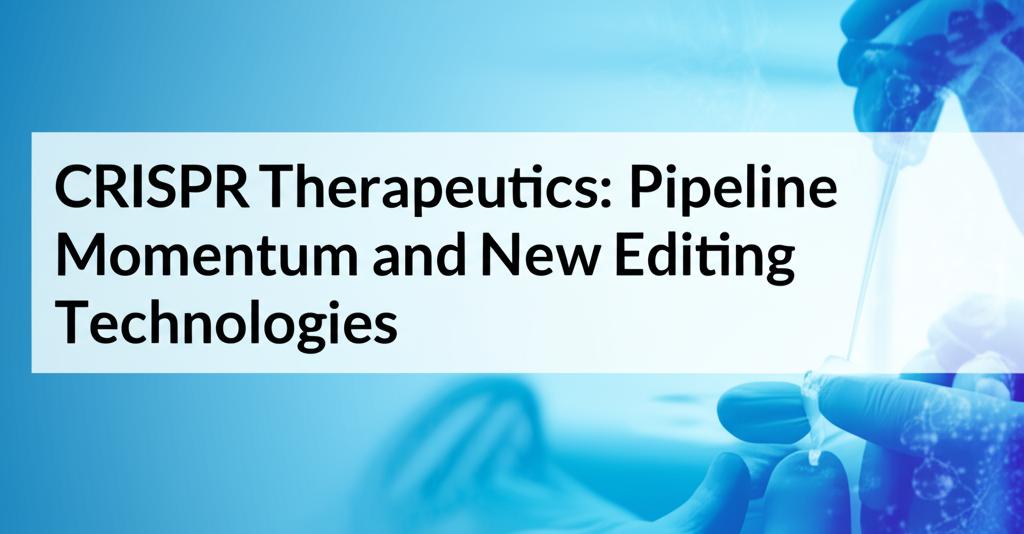CRISPR Therapeutics continues to build momentum following the landmark approval of CASGEVY®, the first CRISPR/Cas9 gene-edited therapy authorized in multiple countries. The company is leveraging this success to drive forward a diverse pipeline, marked by significant advancements in immuno-oncology, autoimmune diseases, and in vivo gene editing, supported by ongoing innovation in editing and delivery technologies.
CASGEVY Commercial Launch Gaining TractionThe global launch of CASGEVY (exagamglogene autotemcel) for sickle cell disease (SCD) and transfusion-dependent beta thalassemia (TDT) is progressing steadily. Developed in partnership with Vertex Pharmaceuticals, CASGEVY is an ex vivo therapy where a patient's own hematopoietic stem cells are edited to increase fetal hemoglobin production. As of the end of 2024, over 50 authorized treatment centers (ATCs) were activated globally, and more than 50 patients had initiated the cell collection process across all regions. Patient demand remains strong, and the number of new patients starting treatment is expected to grow significantly throughout 2025. Furthermore, clinical trials are advancing to expand eligibility, with enrollment completed in Phase 3 studies for children aged 5-11, anticipating dosing completion within 2025. Ongoing research aims to broaden access further through targeted conditioning agents (like an anti-CD117 antibody-drug conjugate) and potentially in vivo editing of hematopoietic stem cells, which could eliminate the need for busulfan conditioning.
Next-Generation Immuno-Oncology and Autoimmune ExpansionCRISPR Therapeutics is strategically focusing its immuno-oncology efforts on its next-generation allogeneic CAR T cell candidates, CTX112™ (targeting CD19) and CTX131™ (targeting CD70). These candidates incorporate novel gene edits (Regnase-1 and TGFBR2 knockouts) designed to enhance potency, persistence, and reduce T cell exhaustion compared to first-generation therapies.
CTX112 is emerging with a potential best-in-class profile. Positive data from the ongoing Phase 1/2 trial in relapsed/refractory B-cell malignancies demonstrate strong efficacy comparable to autologous therapies, robust cell expansion, and a tolerable safety profile. Notably, responses were observed in all 6 patients treated after relapsing or being refractory to prior T-cell engager therapies. These promising results earned CTX112 Regenerative Medicine Advanced Therapy (RMAT) designation from the FDA. The company plans regulatory discussions for CTX112 in B-cell malignancies, with an update expected mid-2025.
Crucially, CRISPR Therapeutics is expanding CTX112 development into autoimmune diseases, leveraging the clinical validation of CD19 targeting. A trial in systemic lupus erythematosus (SLE) has been initiated, with plans to expand into a basket study including systemic sclerosis and inflammatory myositis patients in mid-2025. CTX131 trials are ongoing for solid tumors and are expanding into hematologic malignancies (T- and B-cell), with updates expected during 2025. A strategic partnership with Nkure Therapeutics aims to co-develop and co-commercialize CTX112 in India.
Advancing In Vivo Gene EditingThe company is making significant strides with its in vivo pipeline, primarily utilizing a proprietary lipid nanoparticle (LNP) platform for delivering CRISPR/Cas9 components directly to the liver.
- Cardiovascular Programs: Clinical trials are ongoing for CTX310™ (targeting ANGPTL3 for hypercholesterolemia/dyslipidemias) and CTX320™ (targeting LPA for elevated lipoprotein(a), a cardiovascular risk factor). Dose escalation continues, and clinical updates for both programs are anticipated in the first half of 2025.
- New Preclinical Programs: Two new programs leveraging the LNP platform have advanced into IND/CTA-enabling studies:
CTX340™: Targeting the angiotensinogen (AGT) gene for refractory hypertension.
CTX450™: Targeting the ALAS1 gene for acute hepatic porphyria (AHP).
Clinical trials for both CTX340 and CTX450 are expected to begin in the second half of 2025.
- Other Delivery Approaches: The company is also exploring other delivery methods, such as Adeno-Associated Viral (AAV) vectors for targeting tissues like muscle and the central nervous system, and presented preclinical data on LNP delivery for ocular gene editing targeting the MYOC gene for glaucoma.
In regenerative medicine, CRISPR Therapeutics is advancing programs for Type 1 Diabetes (T1D), including CTX211™, an allogeneic, gene-edited, stem cell-derived therapy using an encapsulation device, which is currently in clinical trials. A deviceless approach, CTX213™, is also under development. Updates from the regenerative medicine portfolio are expected in 2025.
Platform Innovation and Future DirectionsUnderpinning this pipeline progress is a commitment to continuous innovation in gene editing technology and delivery systems. While foundational work uses CRISPR/Cas9, the field is rapidly exploring beyond standard Cas9, including systems like Cas12 and Cas13, base editing, prime editing, and epigenome editing, which offer different functionalities and precision levels. CRISPR Therapeutics emphasizes advancing next-generation editing capabilities and delivery platforms (like LNP and AAV) to broaden the range of addressable diseases and enhance therapeutic potential.
Starting 2025 with a strong financial position (approximately $1.9 billion in cash and equivalents), CRISPR Therapeutics anticipates a catalyst-rich year with significant clinical data updates across its diverse portfolio, further solidifying its leadership in developing transformative gene-based medicines.

